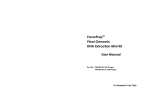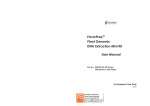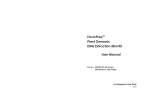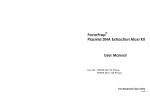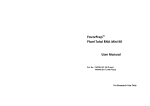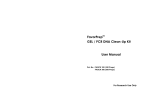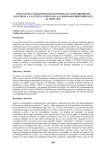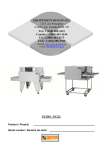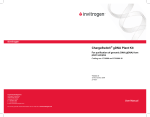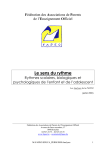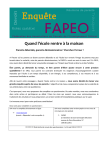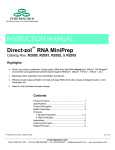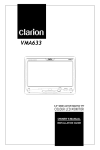Download FavorPrep Plant Genomic DNA Extraction Maxi Kit User Manual
Transcript
FavorPrepTM Plant Genomic DNA Extraction Maxi Kit User Manual Cat. No.: FAPGK 002 (10 Preps) FAPGK 002-1 (24 Preps) For Research Use Only Introduction Genomic DNA Maxi Kit provides a fast and simple method to isolate total Troubleshooting Problem DNA (genomic DNA, mitochondrial and chloroplast) from plant tissue and Insufficient Lysis cells. In the process, sample is distrusted by grinding in liquid nitrogen and Prolong the incubation time in lysis buffer to obtain lysis buffer incubation. The Lysate is treated with RNase A to degrade RNA higher yields of DNA. and filtrated by filter column to remove cell debris and salt precipitations. Insufficient disruption In the presence of binding buffer with chaotropic salt, the genomic DNA in the lysate binds to glass fiber matrix in the spin column. The contaminants Possible Reasons/ Solution For most of species we recommend grinding with Low yield liquid nitrogen. Homogenization should be done thoroughly until the plant material is ground to are washed with an ethanol contained wash buffer and finally, the purified a fine powder. genomic DNA is eluted by low salt elution buffer or water. The protocol does DNA still bound to the membrane not require DNA phenol extraction and alcohol precipitation. The entire The DNA can be either eluted in higher volumes procedure can be completed in 60 minutes. The purified genomic DNA is or by repeating the elution step up to three times. Elution buffer should be preheated to 60oC prior to ready for PCR, real-time PCR, Southern blotting and RFLP. elution. To ensure correct pH, use supplied elution buffer. Quality Control The quality of Plant Genomic DNA Mini Kit is tested on a lot-to-lot basis. The Kits are tested by isolation of genomic DNA from 50 mg young leave. Sample was contaminated with DNase Preheat elution buffer to 60oC for 5 minutes to DNA is Centrifugation speed was too high More than 10 µg of genomic DNA could be quantified with Higher velocities may cause shearing of the DNA. spectrophotometer and checked by agarose gel. The centrifugation maximum speed is at 11,000xg. Too much tissue was used. Too much tissue was used. Reduce the amount of sample material or separate it into multiple tubes. Caution ponent contains irritant agent. During operation, always wear a lab Column coat, disposable gloves, and protective goggles. clogged Sample: 1g of plant tissue eliminate any possible Dnase degraded Insufficient centrifugation Centrifuge again and extend centrifugati on time. Precipitate was formed at DNA Binding Step Reduce the sample material. Yield: 50~300µg Operation time: <80 min 1-FAPGK FAPGK-6 Kit Contents FAPGK 002 (10 preps) Add 4 ml of W1 Buffer into the column. Centrifuge at 4000 X g for 3 minutes. Discard the flow-through and place the FAPG-Maxi Column back in the Collection Tube. Step 4 Wash Add 6 ml of Wash Buffer (ethanol added) into the column. Centrifuge at 4000 X g for 3 minutes. Discard the flow-through and place the FAPG-Maxi Column back in the Collection Tube. FAPGK 002-1 (24 preps) FAPG1 Buffer 45 ml 110 ml FAPGX Buffer 45 ml 110 ml FAPG2 Buffer 13 ml 30 ml FAPG3 Buffer* 30 ml 70 ml W1 Buffer** 33 ml 88 ml Wash Buffer*** 20 ml 45 ml Elution Buffer 30 ml 60 ml RNase A (10mg/ml) 550 ìl 1300 ìl Filter Column 10 pcs 10 pcs FAPG-Maxi Column 10 pcs 10 pcs Centrifuge at 4000 X g for 10 minutes to dry the column matrix. Optional Step: Remove residue pigment If a few pigment remain on the column matrix, perform this optional step. After Wash Buffer, add 4 ml of ethanol (96-100%) in the FAPG-Maxi Golumn. Centrifuge at 4000 X g for 5 minutes. Discard the flow-through and place the FAPG-Maxi Golumn back in the Collection Tubes. Centrifuge again for 10 minutes at 4000 X g to dry the column *Add 60/ 140 ml isopropanol to FAPG3 Buffer When first open. **Add 12/ 32 ml ethanol(96%~100%) to W1 Buffer When first open. martix. ***Add 80/180 ml ethanol(96%~100%) to Wash Buffer When first open. Standard elution volume is 1 ml. If less sample to be used, Step 5 DNA Elution reduce the elution volume (200-500µl) to increase DNA concentration. If higher DNA yield is required, repeat the DNA Elution step to increase DNA recovery and the total elution volume is about 2 ml. Transfer dried FAPG-Maxi into a clean 50 ml centrifuge tube (not provided). Add 1 ml of preheated Elution Buffer into the center of the column matrix. Stand for 5 minutes until Elution Buffer absorbed by the matrix. Centrifuge at 4,000 x g for 3 minutes to elute purified DNA. Protocol Techniical Specification Because of different plant species contain a lot of different metabolites like polysaccharides, polyphenolics, or proteins. Therefore, we provide two different lysis buffers for the various plant samples. The standard protocol uses FAPG1 Buffer for lysis of plant sample. For most of common plant species, the buffer system ensures purified DNA with high yields and a good quality. Alternatively, buffer FAPGX is provided with the kit also. The different detergent in this lysis buffer is suitable for some plant sample with a lot of polysaccharides. 5-FAPGK FAPGK-2 Brief procedure Protocol Cut off 0.5 g (up to 1g) of fresh or frozen plant tissue or 50 mg Step 1 Tissue Dissociation (up to 100 mg) of dried sample. Grind the sample under liquid nitrogen to a fine powder. Transfer it into a 15 ml centrifuge tube (not provided). For some plant sample, we can destruct it without liquid nitrogen. Add 4 ml FAPG1 Buffer (or FAPGX Buffer) and 50µl Rnase A (10 mg/ ml) into the sample tube and mix by vortexing. (Do not mix FAPG1 buffer and RNase A before use.) Incubate at 65oC for 20 minutes. During incubation, invert the tube every 5 minutes. At the same time, preheat required Elution Buffer (2 ml per sample) at 65oC. Step 2 Add 1 ml FAPG2 Buffer and mix by vortexing. Lysis Incubate at ice for 5 minutes. Place a Filter Column in a 50 ml centrifuge tube (not provided). Apply the mixture from previous step to the Filter Column. Centrifuge at 4000 X g for 5 minutes. Discard the Filter Column and carefully transfer clarified supernatant in Collection Tube to a new 50 ml centrifuge tube (not provided). Add 1.5 volumes of FAPG3 Buffer (isopropanol added) to the cleared lysate and mix immediately by vortexing for 10 seconds. Step 3 DNA Binding For example, add 7.5 ml FAPG3 Buffer to 5 ml of lysate. Place a FAPG-Maxi Column in a 50 ml centrifuge tube. Apply the mixture (including any precipitate) from previous step to the FAPG-Maxi Column. Centrifuge at 4000 X g for 5 minutes. Discard the flow-through and place the FAPG-Maxi Column back in the Collection Tube. 3-FAPGK FAPGK-4 Brief procedure Protocol Cut off 0.5 g (up to 1g) of fresh or frozen plant tissue or 50 mg Step 1 Tissue Dissociation (up to 100 mg) of dried sample. Grind the sample under liquid nitrogen to a fine powder. Transfer it into a 15 ml centrifuge tube (not provided). For some plant sample, we can destruct it without liquid nitrogen. Add 4 ml FAPG1 Buffer (or FAPGX Buffer) and 50µl Rnase A (10 mg/ ml) into the sample tube and mix by vortexing. (Do not mix FAPG1 buffer and RNase A before use.) Incubate at 65oC for 20 minutes. During incubation, invert the tube every 5 minutes. At the same time, preheat required Elution Buffer (2 ml per sample) at 65oC. Step 2 Add 1 ml FAPG2 Buffer and mix by vortexing. Lysis Incubate at ice for 5 minutes. Place a Filter Column in a 50 ml centrifuge tube (not provided). Apply the mixture from previous step to the Filter Column. Centrifuge at 4000 X g for 5 minutes. Discard the Filter Column and carefully transfer clarified supernatant in Collection Tube to a new 50 ml centrifuge tube (not provided). Add 1.5 volumes of FAPG3 Buffer (isopropanol added) to the cleared lysate and mix immediately by vortexing for 10 seconds. Step 3 DNA Binding For example, add 7.5 ml FAPG3 Buffer to 5 ml of lysate. Place a FAPG-Maxi Column in a 50 ml centrifuge tube. Apply the mixture (including any precipitate) from previous step to the FAPG-Maxi Column. Centrifuge at 4000 X g for 5 minutes. Discard the flow-through and place the FAPG-Maxi Column back in the Collection Tube. 3-FAPGK FAPGK-4 Kit Contents FAPGK 002 (10 preps) Add 4 ml of W1 Buffer into the column. Centrifuge at 4000 X g for 3 minutes. Discard the flow-through and place the FAPG-Maxi Column back in the Collection Tube. Step 4 Wash Add 6 ml of Wash Buffer (ethanol added) into the column. Centrifuge at 4000 X g for 3 minutes. Discard the flow-through and place the FAPG-Maxi Column back in the Collection Tube. FAPGK 002-1 (24 preps) FAPG1 Buffer 45 ml 110 ml FAPGX Buffer 45 ml 110 ml FAPG2 Buffer 13 ml 30 ml FAPG3 Buffer* 30 ml 70 ml W1 Buffer** 33 ml 88 ml Wash Buffer*** 20 ml 45 ml Elution Buffer 30 ml 60 ml RNase A (10mg/ml) 550 ìl 1300 ìl Filter Column 10 pcs 10 pcs FAPG-Maxi Column 10 pcs 10 pcs Centrifuge at 4000 X g for 10 minutes to dry the column matrix. Optional Step: Remove residue pigment If a few pigment remain on the column matrix, perform this optional step. After Wash Buffer, add 4 ml of ethanol (96-100%) in the FAPG-Maxi Golumn. Centrifuge at 4000 X g for 5 minutes. Discard the flow-through and place the FAPG-Maxi Golumn back in the Collection Tubes. Centrifuge again for 10 minutes at 4000 X g to dry the column *Add 60/ 140 ml isopropanol to FAPG3 Buffer When first open. **Add 12/ 32 ml ethanol(96%~100%) to W1 Buffer When first open. martix. ***Add 80/180 ml ethanol(96%~100%) to Wash Buffer When first open. Standard elution volume is 1 ml. If less sample to be used, Step 5 DNA Elution reduce the elution volume (200-500µl) to increase DNA concentration. If higher DNA yield is required, repeat the DNA Elution step to increase DNA recovery and the total elution volume is about 2 ml. Transfer dried FAPG-Maxi into a clean 50 ml centrifuge tube (not provided). Add 1 ml of preheated Elution Buffer into the center of the column matrix. Stand for 5 minutes until Elution Buffer absorbed by the matrix. Centrifuge at 4,000 x g for 3 minutes to elute purified DNA. Protocol Techniical Specification Because of different plant species contain a lot of different metabolites like polysaccharides, polyphenolics, or proteins. Therefore, we provide two different lysis buffers for the various plant samples. The standard protocol uses FAPG1 Buffer for lysis of plant sample. For most of common plant species, the buffer system ensures purified DNA with high yields and a good quality. Alternatively, buffer FAPGX is provided with the kit also. The different detergent in this lysis buffer is suitable for some plant sample with a lot of polysaccharides. 5-FAPGK FAPGK-2 Introduction Genomic DNA Maxi Kit provides a fast and simple method to isolate total Troubleshooting Problem DNA (genomic DNA, mitochondrial and chloroplast) from plant tissue and Insufficient Lysis cells. In the process, sample is distrusted by grinding in liquid nitrogen and Prolong the incubation time in lysis buffer to obtain lysis buffer incubation. The Lysate is treated with RNase A to degrade RNA higher yields of DNA. and filtrated by filter column to remove cell debris and salt precipitations. Insufficient disruption In the presence of binding buffer with chaotropic salt, the genomic DNA in the lysate binds to glass fiber matrix in the spin column. The contaminants Possible Reasons/ Solution For most of species we recommend grinding with Low yield liquid nitrogen. Homogenization should be done thoroughly until the plant material is ground to are washed with an ethanol contained wash buffer and finally, the purified a fine powder. genomic DNA is eluted by low salt elution buffer or water. The protocol does DNA still bound to the membrane not require DNA phenol extraction and alcohol precipitation. The entire The DNA can be either eluted in higher volumes procedure can be completed in 60 minutes. The purified genomic DNA is or by repeating the elution step up to three times. Elution buffer should be preheated to 60oC prior to ready for PCR, real-time PCR, Southern blotting and RFLP. elution. To ensure correct pH, use supplied elution buffer. Quality Control The quality of Plant Genomic DNA Mini Kit is tested on a lot-to-lot basis. The Kits are tested by isolation of genomic DNA from 50 mg young leave. Sample was contaminated with DNase Preheat elution buffer to 60oC for 5 minutes to DNA is Centrifugation speed was too high More than 10 µg of genomic DNA could be quantified with Higher velocities may cause shearing of the DNA. spectrophotometer and checked by agarose gel. The centrifugation maximum speed is at 11,000xg. Too much tissue was used. Too much tissue was used. Reduce the amount of sample material or separate it into multiple tubes. Caution ponent contains irritant agent. During operation, always wear a lab Column coat, disposable gloves, and protective goggles. clogged Sample: 1g of plant tissue eliminate any possible Dnase degraded Insufficient centrifugation Centrifuge again and extend centrifugati on time. Precipitate was formed at DNA Binding Step Reduce the sample material. Yield: 50~300µg Operation time: <80 min 1-FAPGK FAPGK-6







